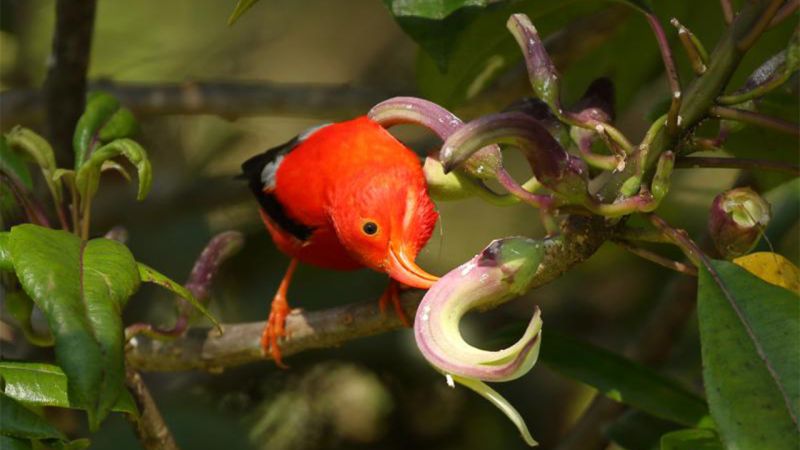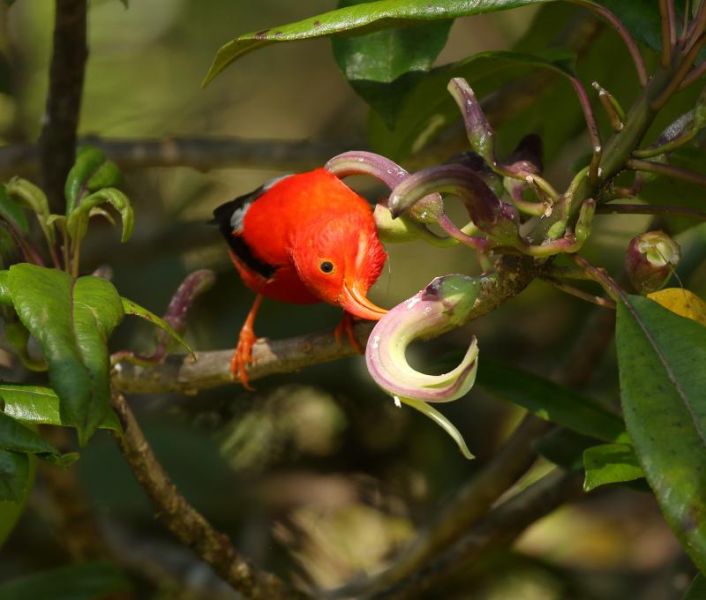Digital Collections
Celebrating the breadth and depth of Hawaiian knowledge. Amplifying Pacific voices of resiliency and hope. Recording the wisdom of past and present to help shape our future.
Kīhei de Silva
Haku mele: Alice Ku‘uleialohapoina‘ole Namakelua (1892–1987).
Sources: 1) Kawai Cockett, who learned it from Aunty Alice Namakelua. 2) Jean Kini Sullivan, on the liner notes of Kawai Cockett’s Beautiful Kaua‘i, Hula Records HS-541.
Discography: Kawai Cockett, Beautiful Kaua‘i, Hula Records HS-541
Text below: As given and translated on the liner notes to Beautiful Kauaʻi. Kini Sullivan indicates that there are two additional verses to the song; these I have yet to locate.*
Haʻaheo Hawaiʻi moku o Keawe
ʻOhuʻohu i ka pua aʻo ka lehua
Ka lehua ʻula me ka lehua kea
Pua hoʻohihi a nā manu.
HUI:
ʻIʻiwi e ka manu kau i ka ʻiu
Hoʻolaʻi i ka lau lāʻau
ʻO ka ʻūlili a ka leo o ke kāhuli
Honehone i ke ahiahi.
Cherished with pride is Hawaiʻi, island of Keawe
Adorned with lehua flowers
With red lehua and white lehua
Flowers fancied by the birds
Chorus:
The ʻiʻiwi is the bird that perches high
Poised in the trees leaves
The whistling voice of the tree shell (answers)
Sweet and soft in the evening.
The ʻiʻiwi is a spectacular, orange-red bird with black wings and a long, curved, salmon colored bill. It was once common in the forests of all the islands but is now limited, for the most part, to the 4,000–7,000 ft. elevations of the forests of Hawaiʻi, Maui, and Kauaʻi. The red feathers of the ʻiʻiwi were a favorite of Hawaiian featherworkers who used them extensively in capes and helmets. The ʻiʻiwi was also a favorite bird of Hawaiian composers of the last century who saw them as symbolic of attractive, eager, and sometimes indiscriminate human lovers. As Andrew Berger reports in Hawaiian Birdlife, 154, this symbolism might have been inspired by the bird’s feeding antics ("visitations to the flowers seem to exhilarate the birds and they become visibly excited as they fly about . . ."), its love for ʻōhiʻa lehua ("many thousands . . . could be seen in a very small area when the great Ohia trees were covered with flowers . . ."), and its friendliness ("it is very tame; all its movements can be examined . . . at a distance of two or three paces . . ." The ʻiʻiwi’s place in Hawaiian kaona (hidden meaning), however, was not limited to that of eye-stopping flirt. Because the bird was also a noted singer whose cheerful voice and enthusiastic, head-up, chest-out posture (Kepelino, in Listen to the Forest, 23) endeared it to the Hawaiian listener, the nickname ʻiʻiwi was sometimes given to much-loved and appreciated Hawaiian vocalists.
Alice Namakelua composed "ʻIʻiwi aʻo Hilo" on May 5, 1950, for the Big Island float of that year’s Kamehameha Day Parade. By then, Aunty Alice had completed 15 of her 24 years of employment at the City and County of Honolulu’s Department of Parks and Recreation (George Kanahele, Hawaiian Music and Musicians, 294). Over the course of a career that began as a teacher of Hawaiian crafts and ended with her retirement in 1958 as a playground director, Aunty Alice found herself in charge of ten Maui and ten Hawaiʻi Island floats in a succession of Parks sponsored Kamehameha Day Parades (Don McDiarmid Jr., liner notes for Auntie Alice Kuʻuleialohapoinaʻole Namakelua, Hula Records, HS-552). "ʻIʻiwi aʻo Hilo" is one of at least four mele that she composed for those occasions; her parade-mele include: "Kuahiwi Nani" (also known as "Haleakalā Hula") for the 1941 Maui float, "ʻIʻiwi aʻo Hilo" for the 1950 Hawaiʻi float, "Aia i Hilo E," for the 1956 Hawaiʻi float, and "Hanohano nō ʻo Hawaiʻi" for the 1958 Hawaiʻi float. When asked how these songs were received by parade participants and spectators, Aunty Alice is said to have responded with characteristic wit; "Now they all want me to ride float so I will make a new song for it" (Sullivan, Auntie Alice…, Hula Records HS-552)."
According to Jean Sullivan (liner notes to Beautiful Kauaʻi), Aunty Alice wrote "ʻIʻiwi aʻo Hilo" as a tribute to the sands of her birth; I wonder, then, why the song was not entitled "ʻIʻiwi aʻo Honokaʻa" since Honokaʻa, Hawaiʻi—not Hilo, Hawaiʻi—was the district in which Aunty Alice was born and raised. I suspect that the answer lies in the song’s biographical nature: Aunty Alice may well be the song’s ʻiʻiwi, and the bird’s Hilo home may well be a reference to her second marriage.
Kuʻuleialohapoinaʻole Kanakaoluna (a teacher who could not pronounce the child's name elected to call her Alice) was born in Honokaʻa in 1892 and was raised in a home filled with Hawaiian music and dance; she started learning to sing at age five, began studying slack key guitar at eight, took up the steel guitar shortly afterwards, and was "constantly tutored by her adoptive father (the brother of her mother) in Hawaiian language and singing" (Kanahele, 263–264). She moved to Honolulu in 1901, and her skills at food preparation, massage, and singing soon made her a favorite of the elderly Queen Liliʻuokalani who "would sit on a favorite chair while I sat on the floor and lomilomi . . . her feet and sing beautiful songs like ʻHiʻilawe,’ ʻWaipiʻo,’ and ʻKa Makani Kaʻili Aloha’ . . ." (Kanahele, 264). At 16, Alice was "the most beautiful girl" her cousin Mary Kawena Pūkuʻi "had ever seen" (McDiarmid); her looks probably helped to attract her first husband Kaluhiokalani, who she married at that tender age, but looks may also have forced her to put aside her love for music and dance. From their marriage in 1908 to Kaluhiokalani’s death at the close of World War I, Alice complied with her husband’s request to give up both: no more singing, no more hula, just to make him happy (McDiarmid).
1919 found Alice single and full of music (it was then that she composed her first songs, "That’s the Wish I Wish to You," and "You are my Rose Bud;” more than 180 Hawaiian language compositions would eventually follow this haole pair). In 1920, she married again, this time to Solomon Namakelua, and moved to Waiākea-Waena, Hilo, where they lived for the next seven years. Aunty Alice’s marriage to Namakelua and their residence in Hilo seems to mark her happy return to the lifestyle in which she was raised. Although her biographers are sketchy at this point, Alice’s new husband apparently placed no restrictions on her musical interests, and she resumed her practice of entertaining "wherever and whenever asked" (McDiarmid).
At some fairly early point in her singing career, I don’t know when, Alice’s sweet voice earned her the nickname ʻIʻiwi aʻo Hilo (Kanahele, 263). It is reasonable to assume that she acquired the name and songbird reputation as a result of her seven year Hilo residence with Namakelua. It is also reasonable to assume that there was nothing accidental about Aunty Alice’s use of her own nickname as the title of "ʻIʻiwi aʻo Hilo." I suggest, then, that her Big Island mele was more than an upbeat song for the Kamehameha Day Parade. The composition seems to have been inspired by memories of her second marriage, her Hilo residence, and her rededication, there, to things Hawaiian. It was in Hilo that Aunty Alice found the freedom to sing again; she may well be the beautiful, irrepressible songbird of "ʻIʻiwi aʻo Hilo;" the singing tree snail that answers her may well be her second husband; and the soft, evening-time exchange of ʻiʻiwi and kāhuli may well reflect the harmony of their marriage.
Alice and Solomon Namakelua moved to Honolulu in 1927. He died in 1929, leaving her to care for two children. For five years, she supported her family by performing "casuals and odd jobs" (Kanahele), and in 1935 she joined the Honolulu Parks Department. Fifteen years later, she composed a parade-float tribute to a bird of the island of her birth; my guess, however, is that the kaona of "ʻIʻiwi aʻo Hilo" lies less with actual Big Island birds than with Aunty Alice herself, and less with her birth in Honokaʻa than with her rebirth in Hilo.
The essay above was written by Kīhei de Silva and published in his book He Aloha Moku o Keawe: A Collection of Songs for Hawaiʻi, Island of Keawe, Honolulu, 1997, pps. 6–8. It is offered here, in slightly revised and updated form, with his express consent. He retains all rights to this essay; no part of it may be used or reproduced without his written permission.
* Kini Sullivan has recently—and very generously—shared these verses with me (personal communication, Nov. 7, 1998). They shift in setting, in a manner reminiscent of Liliʻuokalani’s "Ninipo, Hoʻonipo," from Hilo to Puna, and from flower infatuation to liquid immersion. Although the final two lines of both "new" verses reflect the Big-Island-float context of the song’s composition (verse 2 praises Kamehameha Paiʻea; verse 3 boasts of Hawaiʻi’s supremacy), the early, personal undercurrent of ebullience and love continues to run here unabated.
ʻIke i ka wai welawela aʻo Puna
Me ke kumu kukui a nā 'liʻi
Auhea ʻoe Hawaiʻi e ō mai
ʻĀina hānau o Pai'ea
Hōpoe ka wahine lewa i ke kai
Hoʻoipo ana hoi me Lohi'au
Luana ʻia koʻu manaʻo
Hawaiʻi nō lā e ka ʻoi
Know the hot springs of Puna
And the founding light of the chiefs
Please take heed, Hawaiʻi, respond
Land of Paiʻea’s birth
Hōpoe is the woman who sways in the sea
Romancing with Lohiʻau
I am content with the thought
Hawaiʻi, indeed, is the best
[Translation: KdS]


photo credit: Bret N. Mossman
From Ka Nupepa Kuokoa, May 23, 1863. The ʻiʻiwimakapōlena is like the mamo, the ʻōʻō, and the ʻōʻū in that its beak is a beautiful yellow, long, and finely curved and that its head is compact and nicely tapered. The ʻiʻiwi’s body feathers are a ruddy, bright red; its wing feathers are dark black, as are its tail feathers; its legs are a fiery yellow, as are its feet all the way to the claws; its eyes are intensely yellow. Like the mamo, the ʻiʻiwi feeds on the nectar of the lehua as well as on a variety of other items. The ʻiʻiwi is a merry-voiced bird; when it is ready to break into song, its heads goes up, its neck puffs out, and its tail feathers rise and stand straight up—then it sings. It sounds like this: “ko-koki” and “ko” again. The ʻiʻiwi is a very alert bird; its liveliness and constant attention to searching far and wide for food is extraordinary; it does so with great interest and unhesitating speed. Because of its industry and devotion, it seems to alight here, there, and everywhere in defiance of the lazy, the immovably comfortable, the apathetic, and the sleeping. [This is a somewhat liberal translation of the opening paragraphs of a longer, Hawaiian-only article that appeared in the already cited 1863 edition of Kuokoa.]